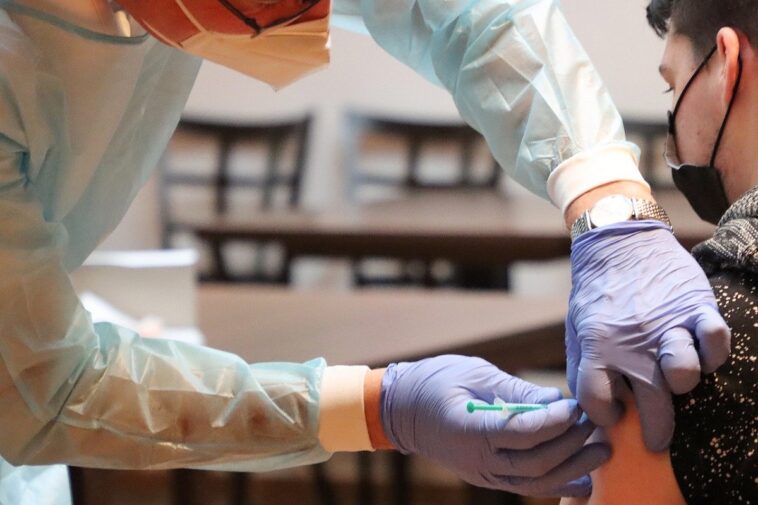New York State has not released demographics (vaccine) online for those who completed the full series of vaccinations. To date, more than 1.3 million New Yorkers have done so, which is less than 7 percent of the state’s population.
New York’s 2 largest vaccine center sites to date in Brooklyn, Queens
New York City does not provide this data separately either. The city has delivered nearly 1.6 million total doses to date, including more than 910,000 first doses and more than half a million-second doses. These numbers include people who do not live in New York City but who may be vaccinated because of their work in the five boroughs. Of all New Yorkers who received at least one dose, only 12 percent are black and 16 percent are Latinos.
According to the latest federal population data, these racial groups make up 24 percent and 29 percent of the urban population, respectively.
The city has set up several vaccination centers for color and lower-income communities in recent weeks, including the Yankee Stadium site, which is jointly operated with the state and serves only Bronx residents.
Mayor Bill de Blasio has launched a series of vaccination campaigns in the community to increase coverage. “We’re focused on equity. We’re focused on making sure people in the neighborhoods that have suffered most from COVID have access to vaccination, the support they need, the information they need, the answers, that they need.”, the range they need, “said de Blasio on Wednesday.
75 percent of the city-operated locations that have opened to date are in these priority neighborhoods, he said. The city has opened 19 locations in NYCHA locations and will add another seven this week with 2,000 dates available, the mayor said. “This is how we build momentum,” he added.
Governor Andrew Cuomo is dividing the state into 10 regions for testing purposes and tracking positivity rates to identify potential hotspots. Find the latest tracking data by region and for the five counties. Serious racial/ethnic differences can also be found in the Garden State. Of those vaccinated, only 4 percent are black, although they make up about 13 percent of the state’s population. The vaccination rates for Latinos are even lower compared to their percentage of the population. This group makes up only 5 percent of the state’s vaccinations so far, despite making up about 18 percent of the population, data from New Jersey shows.
In Connecticut, health department data suggests “there are also differences in vaccine delivery across racial boundaries,” Governor Ned Lamont said Tuesday when he promised to assign adequate vaccines to the underserved.
The differences are in stark contrast to significantly higher COVID infection and death rates in black and Latin American communities compared to white communities in the Tri-State. As Lamont said, “People of color are twice as likely to be infected and have complications and vaccinated half as likely”.
In the three states, more than 7,000 providers are ready to accelerate the rollout once the supply is more stable. The White House has announced many additional upswings in the past few weeks and plans to provide more support to supplies over the next month. According to city officials, federal emergency use approval for Johnson & Johnson’s single-dose vaccine would greatly improve care.
The likelihood of this soon rose on Wednesday when the FDA said its analysis showed that J & J’s vaccine is safe and effective. The agency’s independent advisors will discuss whether the evidence is strong enough to recommend Friday’s long-awaited emergency shot. The single-dose vaccine could provide a much-needed infusion in a national vaccine rollout that has slowly begun to increase its weekly allocation to states. Even before the latest J&J news, Dr. Dave Chokshi, New York’s chief health officer, who himself battled COVID-19 earlier this month, said the government said it would increase the allocation significantly by April, on top of previous incremental increases.
Most municipalities have used some of the increased supply to start vaccinating vital personnel such as fire brigades, police, and teachers. According to Cuomo, the state will begin tracking vaccination numbers weekly. He said this is part of President Joe Biden’s drive to open schools and will also find out how many teachers are studying in class as many educators are concerned about going back to the classroom without a vaccine.
The race for vaccination has grown in urgency as more contagious variants, first identified overseas, become more common in the United States, and the virus threatens to spread faster when the country hits its recent peak.
Overall, vaccines are expected to work on the variants that have emerged and will emerge over time. To date, the United States has given more than 65 million vaccine doses in total, nearly 20 million of those second shots (about 6 percent of the country’s population, according to the CDC).
- Facebook Messenger

